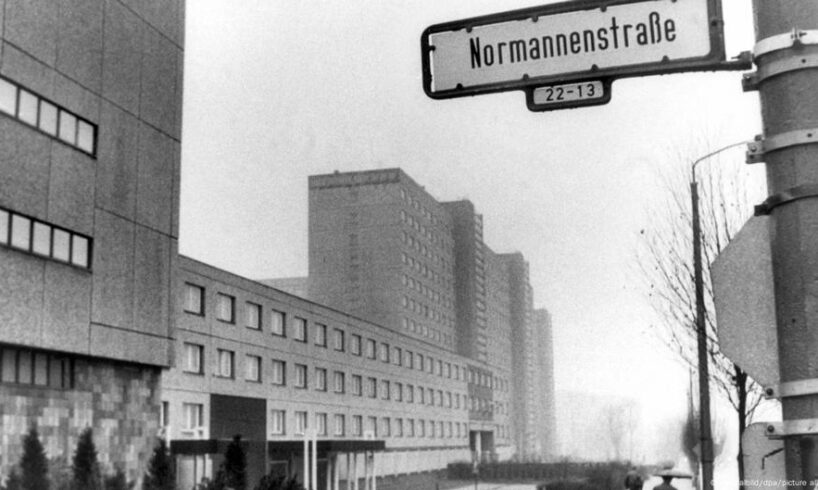
“Comrades, we must know everything!” Erich Mielke’s message was clear. As director of East Germany’s Ministry for State Security (commonly known as the Stasi) from 1957 to 1989, he oversaw the systematic surveillance of its citizens.
Stasi informants could potentially be found anywhere, even among colleagues or friends. Their task was to detect people labeled as “harmful” to society. In the eyes of the German Democratic Republic (GDR) regime, this included anyone who criticized the system and cooperated with the so-called “class enemy.”
This reasoning legitimized the construction of the Berlin Wall in 1961, which the GDR called the “anti-fascist protection barrier” against the “imperialist” or “fascist” capitalists in the West.
Stasi methods: surveillance and intimidation
To the GDR, the enemy was everywhere. For the Stasi secret police, which was founded in 1950, anything could arouse suspicion: From a joke about the Chairman of the State Council, to listening to non-conformist music, to receiving letters with stamps from the West, or asking for a visitor’s permit to enter West Germany.
As “the shield and sword of the party,” the Stasi was in charge of maintaining the rule of the Socialist Unity Party of Germany (SED) by clamping down on any opposition.
Stasi officials would spy on people by reading their mail, wiretapping their calls and entering their apartments illegally. They would intimidate people and spread rumors — that they were alcoholic, or gay, for instance — to discredit them.
In an especially deceitful move, agents would sometimes even spread lies about someone working for the Stasi. Many GDR citizens were imprisoned after criticizing the regime.
Stasi HQ in Berlin: East Germany’s secret service at work
To view this video please enable JavaScript, and consider upgrading to a web browser that supports HTML5 video
Why people worked for the Stasi
Colloquially, the Stasi was known as “Die Firma” (The Company) or “Horch und Greif” (Listen and Nab). Around 90,000 people worked for the Stasi full-time, while 100,000-200,000 “informal collaborators” (depending on the source) worked as informants before November 1989 when the Berlin Wall fell.
These unofficial informants would spy on their friends and family — either willingly, or because they themselves were put under pressure.
But what made them work for the authoritarian regime?
That depends, said historian Philipp Springer, whose book, “Die Hauptamtlichen” (Staffing the Stasi), was published in July in Germany.
“One reason was to the feeling of having power over your fellow citizens,” Springer explained of motivations for joining the Stasi. “And then there were the promises made by the ministry, which would claim that the job was interesting and might even allow for deployments abroad. At the end of the day, it was a very secure job to have — especially for people struggling with their career prospects.”
‘Less exciting that you might imagine’
When researching his book, the author re-discovered rare photographs of Stasi officials at work from the Stasi Records Archive.
As spies and informants, Stasi employees were usually behind the camera, not in front. Looking at the photos, the promise of an exciting life as a secret service agent quickly fades.
“There might have been a few aspects of a James Bond life if you were deployed abroad and were involved in espionage,” said Springer. “[But] if you weren’t directly involved in espionage, then most of it was a lot less exciting that you might imagine.”
Which is also why the photos in the book seem somewhat dull and amateurish: A man standing at a copying machine, for instance, or another man sitting at his desk. A woman working in the kitchen, or sometimes, just a hand reaching for the index card box.
“Of course, these are all pretty normal things to see and not really exciting,” Springer reiterates. “But at the end of the day, all these Stasi employees helped to keep the state apparatus going. They were all part of the system and had been trained politically and ideologically … they were defending the socialist GDR against the West.”
The former headquarter of the Stasi is now a museum that exhibits the mundane routine of spy work Image: Hannibal Hanschke/dpa/picture alliance
Outing of spies is justified
The author tried to include the biographies of some subjects in the photos, including first lieutenant Elfi-Elke Martens, whose father had already worked for the Stasi — as did her husband. Described as “ready for duty” and praised as “diligent and devoted,” she promised to try to stop a relative from traveling to the West.
“My husband and I will speak to hear again, and should she not be ready to cancel her trip, we will cut all ties to her,” Martens said.
A corporal Sylke Kindler, also featured in the book, had proposed attaching a camera to the bottom of a shopping basket in order secretly take photos. Major general Horst Böhm was so loyal to the regime that he even committed suicide after the dissolution of the GDR.
“You often think: OK, they were just a tiny clog in this huge machine,” Spinger said. “But at the end of the day … they chose to invest a lot of time and energy to work for this authoritarian regime. And so they must also face the fact that there are files about them.”
Learning from the past
It was finally over for the GDR intelligence service following the fall of the Wall and German reunification.
On January 15, 1990, thousands of demonstrators stormed the Stasi headquarters. Almost 15,000 bags of destroyed Stasi documents were discovered, but authorities were able to preserve more than 111 kilometers of files, 41 million index cards and over 1.7 million photos collected over decades.
East German demonstrators storm the Stasi headquarters on June 15, 1990 as tens of thousands wait outsideImage: Jockel Finck/AP/picture alliance
Many East Germans submitted applications to view their personal files. Some discovered that information had been gathered by friends and even family. Still today, there are many requests for files from former GDR citizens, says Springer.
“In my opinion this matter should also be given greater attention on a political or national level, because injustice was committed here by an entire apparatus. It is important to keep the memory alive,” he said.
Future generations who “have a responsibility to safeguard our democratic system” need to understand what happened, he added.
This article was originally written in German.





